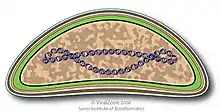Ascoviridae
Ascoviridae is a family of double strand DNA viruses that infect primarily invertebrates, mainly noctuids and spodoptera species; it contains two genera, Ascovirus, which contains three species, and Toursvirus with a single species Diadromus pulchellus toursvirus.[1][2][3]
| Ascoviridae | |
|---|---|
 | |
| Virus classification | |
| (unranked): | Virus |
| Realm: | Varidnaviria |
| Kingdom: | Bamfordvirae |
| Phylum: | Nucleocytoviricota |
| Class: | Megaviricetes |
| Order: | Pimascovirales |
| Family: | Ascoviridae |
| Genera | |
| |
Taxonomy
The family contains the following genera and species:[4]
- Ascovirus
- Heliothis virescens ascovirus 3a
- Spodoptera frugiperda ascovirus 1a
- Trichoplusia ni ascovirus 2a
- Toursvirus
- Diadromus pulchellus toursvirus
Genome

The genome is not segmented and contains a single molecule of circular double-stranded DNA. The genome has a guanine + cytosine content of 42-60%.
The genome of Spodoptera frugiperda ascovirus 1a has been sequenced.[5] It is 156,922 bases in length and encodes 123 putative open reading frames. The G+C ratio is 49.2%. Among the encoded proteins are a caspase, a cathepsin B, several kinases, E3 ubiquitin ligases, a fatty acid elongase, a sphingomyelinase, a phosphate acyltransferase and a patatin-like phospholipase.[5]
Virology
The virions consist of an envelope, a core, and an internal lipid membrane associated with the inner particle. The virus capsid is enveloped and measures 130 nm in diameter, and 200-240 nm in length. Virions are bacilliform, ovoid, and allantoid.
| Genus | Structure | Symmetry | Capsid | Genomic arrangement | Genomic segmentation |
|---|---|---|---|---|---|
| Ascovirus | Bacilliform, ovoidal or allantoid | Enveloped | Circular | Monopartite |
These viruses infect immature stages of the order Lepidoptera, in which they cause a chronic, fatal disease.[6] They are transmissed by endoparasitic wasps and the host develops a unique cytopathology that resembles apoptosis. Cell infection induces apoptosis and in some species is associated with synthesis of a virus-encoded executioner caspase and several lipid-metabolizing enzymes. After infection the host cell DNA is degraded, the nucleus fragments and the cell then cleaves into large virion-containing vesicles. Synthesis of viral proteins results in the rescue of developing apoptotic bodies that are converted into large vesicles in which virions accumulate and continue to assemble. In infected larvae, millions of these virion-containing vesicles begin to disperse from infected tissues 48–72 hours after infection into the haemolymph, making it milky white, a characteristic of this disease. The circulation of virions and vesicles in the blood facilitates mechanical transmission by parasitic wasps.[6]
| Genus | Host details | Tissue tropism | Entry details | Release details | Replication site | Assembly site | Transmission |
|---|---|---|---|---|---|---|---|
| Ascovirus | Insects: Noctuids | Most | Cell receptor endocytosis | Cleavage | Nucleus | Cytoplasm | Mechanical |
Evolution
Ascoviruses evolved from iridoviruses (family Iridoviridae) that also attack lepidopteran larvae.[6] Furthermore, ascoviruses have been suggested as the evolutionary source of ichnoviruses (family Polydnaviridae),[6][7] although other studies have not been able to confirm this link.[8]
References
- Asgari S, Bideshi DK, Bigot Y, Federici BA, Cheng XW (January 2017). "ICTV Virus Taxonomy Profile: Ascoviridae". The Journal of General Virology. 98 (1): 4–5. doi:10.1099/jgv.0.000677. PMC 5370392. PMID 28218573.
- "Ascoviridae". ICTV Online (10th) Report.
- "Viral Zone". ExPASy. Retrieved 12 June 2015.
- "Virus Taxonomy: 2020 Release". International Committee on Taxonomy of Viruses (ICTV). March 2021. Retrieved 22 May 2021.
- Bideshi DK, Demattei MV, Rouleux-Bonnin F, Stasiak K, Tan Y, Bigot S, et al. (December 2006). "Genomic sequence of Spodoptera frugiperda Ascovirus 1a, an enveloped, double-stranded DNA insect virus that manipulates apoptosis for viral reproduction". Journal of Virology. 80 (23): 11791–805. CiteSeerX 10.1.1.332.7512. doi:10.1128/JVI.01639-06. PMC 1642580. PMID 16987980.
- Federici BA, Bideshi DK, Tan Y, Spears T, Bigot Y (2009). "Ascoviruses: Superb Manipulators of Apoptosis for Viral Replication and Transmission". Lesser Known Large dsDNA Viruses. Current Topics in Microbiology and Immunology. Vol. 328. pp. 171–96. doi:10.1007/978-3-540-68618-7_5. ISBN 978-3-540-68617-0. PMID 19216438.
- Bigot Y, Samain S, Augé-Gouillou C, Federici BA (September 2008). "Molecular evidence for the evolution of ichnoviruses from ascoviruses by symbiogenesis". BMC Evolutionary Biology. 8 (1): 253. doi:10.1186/1471-2148-8-253. PMC 2567993. PMID 18801176.
- Volkoff AN, Jouan V, Urbach S, Samain S, Bergoin M, Wincker P, et al. (May 2010). Asgari S (ed.). "Analysis of virion structural components reveals vestiges of the ancestral ichnovirus genome". PLOS Pathogens. 6 (5): e1000923. doi:10.1371/journal.ppat.1000923. PMC 2877734. PMID 20523890.
External links
- ICTV Online (10th) Report: Ascoviridae/
- Viralzone: Ascoviridae/
- Ascoviridae at the US National Library of Medicine Medical Subject Headings (MeSH)